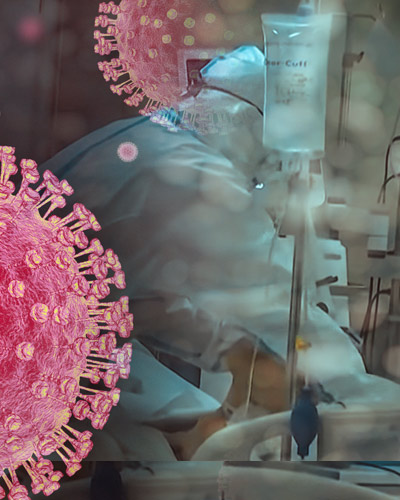May 11, 2021 | Deborah Kotz
UM School of Medicine Researchers Find Reassuring Evidence that Pregnancy Does Not Increase Patient’s Risk of Dying When Hospitalized with Pneumonia
 Pregnant women who develop severe COVID-19 infections that require hospitalization for pneumonia and other complications may not be more likely to die from these infections than non-pregnant women. In fact, they may have significantly lower death rates than their non-pregnant counterparts. That is the finding of a new study published today in the Annals of Internal Medicine conducted by researchers at the University of Maryland School of Medicine (UMSOM).
Pregnant women who develop severe COVID-19 infections that require hospitalization for pneumonia and other complications may not be more likely to die from these infections than non-pregnant women. In fact, they may have significantly lower death rates than their non-pregnant counterparts. That is the finding of a new study published today in the Annals of Internal Medicine conducted by researchers at the University of Maryland School of Medicine (UMSOM).
The study examined medical records from nearly 1,100 pregnant women and more than 9,800 non-pregnant patients aged 15 to 45 who were hospitalized with COVID-19 and pneumonia. Slightly less than 1 percent of the pregnant patients died from COVID-19 compared to 3.5 percent of non-pregnant patients, according to the study findings.
There are, however, some important caveats to the study data in terms of differences between the two populations. Pregnant patients were more likely to be younger and have fewer health conditions, including diabetes, obesity, hypertension, and chronic lung disease, compared to the non-pregnant patients. Given the small number of deaths seen in the study, the researchers were unable to control for these differences to determine whether they significantly affected mortality risk.
“I think this is reassuring news for women who are pregnant and worried about getting infected with COVID-19 as new variants emerge,” said study-corresponding author Anthony Harris, MD, MPH, Professor of Epidemiology & Public Health at UMSOM. “While the study does not tell us for certain that pregnancy does not pose added risks for women, the data certainly points in that direction.”
Researchers from The University of Texas Health Science Center at Houston also participated in this study. UMSOM faculty who were co-authors of this study include Katherine Goodman, JD, PhD, Lisa Pineles, MA, Lyndsay O’Hara, PhD, Gita Nadimpalli, MD, MPH, Laurence Magder, PhD, and Jonathan Baghdadi, MD, PhD.

“I am so pleased we can provide some reassuring news to pregnant women who have faced an added burden during the COVID-19 pandemic,” said E. Albert Reece, MD, PhD, MBA, Executive Vice President for Medical Affairs, UM Baltimore, and the John Z. and Akiko K. Bowers Distinguished Professor and Dean, University of Maryland School of Medicine. "This is an important study that adds to our knowledge of the COVID-19 pandemic at a critical time.”
About the University of Maryland School of Medicine
Now in its third century, the University of Maryland School of Medicine was chartered in 1807 as the first public medical school in the United States. It continues today as one of the fastest growing, top-tier biomedical research enterprises in the world -- with 46 academic departments, centers, institutes, and programs, and a faculty of more than 3,000 physicians, scientists, and allied health professionals, including members of the National Academy of Medicine and the National Academy of Sciences, and a distinguished two-time winner of the Albert E. Lasker Award in Medical Research. With an operating budget of more than $1.2 billion, the School of Medicine works closely in partnership with the University of Maryland Medical Center and Medical System to provide research-intensive, academic and clinically based care for nearly 2 million patients each year. The School of Medicine has nearly $600 million in extramural funding, with most of its academic departments highly ranked among all medical schools in the nation in research funding. As one of the seven professional schools that make up the University of Maryland, Baltimore campus, the School of Medicine has a total population of nearly 9,000 faculty and staff, including 2,500 students, trainees, residents, and fellows. The combined School of Medicine and Medical System (“University of Maryland Medicine”) has an annual budget of over $6 billion and an economic impact of nearly $20 billion on the state and local community. The School of Medicine, which ranks as the 8th highest among public medical schools in research productivity (according to the Association of American Medical Colleges profile) is an innovator in translational medicine, with 606 active patents and 52 start-up companies. In the latest U.S. News & World Report ranking of the Best Medical Schools, published in 2021, the UM School of Medicine is ranked #9 among the 92 public medical schools in the U.S., and in the top 15 percent (#27) of all 192 public and private U.S. medical schools. The School of Medicine works locally, nationally, and globally, with research and treatment facilities in 36 countries around the world. Visit medschool.umaryland.edu
About the University of Maryland Medical System
The University of Maryland Medical System (UMMS) is a university-based regional health care system focused on serving the health care needs of Maryland, bringing innovation, discovery and research to the care we provide and educating the state’s future physician and health care professionals through our partnership with the University of Maryland School of Medicine and the UM Schools of Nursing, Pharmacy, Social Work and Dentistry in Baltimore. As one of the largest private employers in the State, the health system’s 28,000 employees and 4,000 affiliated physicians provide primary and specialty care in more than 150 locations and at 13 hospitals. UMMS’ flagship academic campus, the University of Maryland Medical Center in Baltimore is partnered with the University of Maryland School of Medicine and is recognized regionally and nationally for excellence and innovation in specialized care. Our acute care and specialty rehabilitation hospitals serve urban, suburban and rural communities and are located in 13 counties across the State. For more information, visit www.umms.org.
Contact
Deborah Kotz
410-706-4255
dkotz@som.umaryland.edu
Related stories

Friday, April 05, 2024
Researchers Identify New Genetic Risk Factors for Persistent HPV Infections
Human papillomavirus (HPV) is the second most common cancer-causing virus, accounting for 690,000 cervical and other cancers each year worldwide. While the immune system usually clears HPV infections, those that persist can lead to cancer, and a new finding suggests that certain women may have a genetic susceptibility for persistent or frequent HPV infections. These genetic variants, identified in a study led by University of Maryland School of Medicine researchers, could raise a woman’s risk of getting cervical cancer from a high-risk HPV infection.

Thursday, October 12, 2023
UM School of Medicine Researchers Provide First Statewide Prevalence Data on Two New Emerging Pathogens in Healthcare Settings
University of Maryland School of Medicine (UMSOM) researchers conducted a statewide survey of all patients on breathing machines in hospitals and long-term care facilities and found that a significant percentage of them harbored two pathogens known to be life-threatening in those with compromised immune systems. One pathogen, Acinetobacter baumannii, was identified in nearly 31 percent of all patients on ventilators to assist with their breathing; Candida auris was identified in nearly 7 percent of patients on ventilators, according to the study which was published today in the Journal of the American Medical Association.

Tuesday, November 01, 2022
Youngest Girls Who Get Pregnant Have Highest Risk of Poor Outcomes, Study Finds
Pregnant teens in the U.S. have long been known to face increased health risks and pregnancy complications, but a new study for the first time finds that girls ages 13 or younger who get pregnant face even greater risks. These very young girls are significantly more likely to experience preterm birth, cesarean delivery, and admission to the intensive care unit (ICU) compared to older pregnant teens. Researchers from the University of Maryland School of Medicine (UMSOM) and the University of Pennsylvania Perelman School of Medicine led the study, which was published today in the Journal of the American Medical Association (JAMA).

Tuesday, May 31, 2022
Most Doctors Still Believe in Prescribing Unnecessary Antibiotics to Treat Asymptomatic Infections, UM School of Medicine Study Suggests
An estimated 70 percent of primary care physicians reported in a survey that they would still prescribe antibiotics to treat asymptomatic infections based solely on a positive urine specimen. This is despite long-held medical guidelines recommending against this practice, according to a new study published in JAMA Network Open, which was led by University of Maryland School of Medicine (UMSOM) researchers.

Tuesday, March 16, 2021
New Study Finds Healthcare Settings Do Not Pose Added Risk Factor for Covid-19 Infection Spread Among U.S. Healthcare Personnel
Healthcare personnel who were infected with COVID-19 faced stronger risk factors outside of the workplace than in their hospital or healthcare settings. That is the finding of a new study published today in the Journal of the American Medical association's JAMA Network Open conducted by University of Maryland School of Medicine (UMSOM) researchers and colleagues at the Centers for Disease Control and Prevention (CDC) and three other universities.

Tuesday, December 22, 2020
Largest Study of Its Kind Identifies Which COVID-19 Patients Face the Greatest Risk of Mortality During Hospitalization
Hospitalized COVID-19 patients have a greater risk of dying if they are men or if they are obese or have complications from diabetes or hypertension, according to a new study conducted by University of Maryland School of Medicine (UMSOM) researchers. In a study published in the journal Clinical Infectious Diseases, the researchers evaluated nearly 67,000 hospitalized COVID-19 patients in 613 hospitals across the country to determine the link between certain common patient characteristics and the risk of dying from COVID-19. Their analysis found that men had a 30 percent higher risk of dying compared to women of the same age and health status. Hospitalized patients who were obese, had hypertension or poorly managed diabetes had a higher risk of dying compared to those who did not have these conditions. Those aged 20 to 39 with these conditions had the biggest difference in their risk of dying compared to their healthier peers.

Monday, August 17, 2020
UMSOM’s Department of Epidemiology and Public Health Center of Excellence in Infection Control Awarded CDC Funds for COVID-19 Research
The Department of Epidemiology and Public Health (EPH) at the University of Maryland School of Medicine was recently awarded $900,000 for COVID-19 research from the Centers for Disease Control and Prevention (CDC). The funding will be used by faculty in the Department’s Division of Genomic Epidemiology and Clinical Outcomes for research to help identify the most effective measures for COVID-19 infection control in healthcare settings.

Tuesday, January 23, 2018
Novel Gene Mutations Linked to High HDL Cholesterol and Apparent Protection from Heart Disease
Researchers at the University of Maryland School of Medicine (UMSOM) have uncovered genetic mutations that may explain why people with high levels of high-density lipoprotein (HDL) cholesterol, the “good cholesterol,” have a reduced risk of coronary heart disease.

